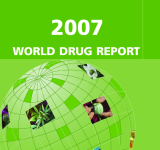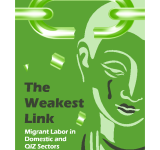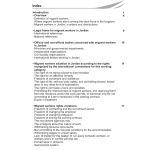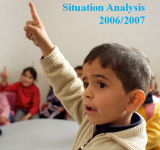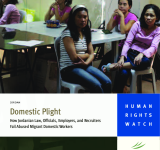The negative impacts of the illicit drug trade touch every society in the world. This year's World Drug Report estimates that 200 million people;; or 5% of the global population age 15-64;; have consumed illicit drugs at least once in the last 12 months. The drug trade is pernicious and large. UNODC estimates its retail value at US$ 321bn. It impacts almost every level of human security from individual health;; to safety and social welfare. Its consequences are especially devastating for countries with limited resources available to fight against it. The World Drug Report 2005 provides one of the most comprehensive overviews of illicit drug trends at the international level. In addition;; this year it presents the work of UNODC in two new areas of research. Both aim to provide tools to enrich our understanding of an immensely complex situation: an estimate of the financial value of the world drug market;; and the preliminary steps towards the creation of an illicit drug index. The analysis of trends;; some going back 10 years or more;; is presented in Volume 1. Detailed statistics are presented in Volume 2. Taken together these volumes provide the most up to date view of today's illicit drug situation.
trafficking
An estimated 3 % of the global population;; or 185 million people consume illicit drugs annually. Among this population are people from almost every country on earth and from every walk of life. Countless more people;; around the world;; are involved in the production and trafficking of illicit drugs;; and still more are touched by the devastating social and economic costs of this trade. These people live in both developed and developing countries;; are rich and poor;; healthy and unhealthy;; citizens and refugees. Illicit drugs are a truly global phenomenon. Partially a consequence of this pervasiveness;; and partially a consequence of the illicit and hidden nature of this trade;; reliable analysis and statistics on the production;; trafficking and consumption of illicit drugs are rare. In cooperation with Member States;; the United Nations Office on Drugs and Crime (UNODC) has endeavoured to fill the gaps. In this first edition of the new two volume World Drug Report;; UNODC presents more quantitative data than ever before in an effort to increase the amount of factual evidence available in a field which is so notoriously difficult to quantify. This year;; the analysis of trends;; some going back ten years or more;; is presented in Volume 1. Detailed statistics are presented in Volume 2. Taken together these volumes will provide the most complete picture yet on today's illicit drug situation.
Some 200 million people;; or 5 percent of the global population age 15-64;; have used illicit drugs at least once in the last 12 months. Among this population are people from almost every country on earth. More people are involved in the production and trafficking of illicit drugs and still more are touched by the devastating social and economic costs of this problem. Partially a consequence of its pervasiveness and partially a consequence of the illicit and hidden nature of the problem;; reliable analysis and statistics on the production;; trafficking and use of illicit drugs are rare. The World Drug Report 2006 endeavours to fill this gap. It provides one of the most comprehensive overviews of illicit drug trends at the international level. In addition;; it presents a special thematic chapter on cannabis;; by far the most widely produced;; trafficked and used drug in the world. The analysis of trends;; some going back 10 years or more;; is presented in Volume 1. Detailed statistics are presented in Volume 2. Taken together;; these volumes provide the most up-to-date view of today's illicit drug situation.
The World Drug Report presents the most comprehensive statistical view of today's illicit drug situation. This year's edition reports signs of long-term containment of the global problem. However;; the overall trend masks contrasting regional situations;; which the report examines in detail. For instance;; while an impressive multi-year reduction in opium poppy cultivation continued in South-East Asia;; Afghanistan recorded a large increase in 2006. More interceptions of cocaine and heroin shipments across the world have played an important part in stabilizing the market. However;; as we witness successes in some areas;; challenges appear in others. Although drug abuse levels are stabilizing globally;; countries along major and new trafficking routes;; such as those now going through Africa;; may face increasing levels of drug consumption. The World Drug Report 2007 also discusses a possible method to better assess and monitor the role played by organized crime in transnational drug trafficking.
This report is the second annual report of Tamkeen Center for Legal Aid and Human Rights. It addresses the status of both migrant domestic workers and migrant workers in Qualified Industrial Zones because these two categories are subject to recurrent abuses and are the most vulnerable group due to legislative reasons;; administrative practices and the actions of their employers.
The migrant worker in Jordan situation report was issued in 2009. It presents an overview of the situation of migrant workers in Jordan and the main violations they are subject to. Additionally;; the report offers recommendations to national and international parties concerned with the migrant workers' rights.
يهدف هذا التقرير الى تحليل الانجازات التي تحققت للأطفال في الأردن. ويتضمن التقرير معلومات وإحصاءات عن صحة الأطفال والتعليم والمشاركة بالإضافة إلى حماية الطفل. ويشير أيضا الى ما يجب القيام به ويبين ما هي الفجوات. وكان أبرز ما خلص إليه التقرير أن الصحة العامة والصحة الإنجابية ليست موجهة بشكل كاف لاحتياجات المراهقين;; وكما أن التوعية الصحية متدنية بين الفتيات والذكور;; اضافة الى محدودية فرص الحصول على المعلومات والتثقيف حول نمط الحياة الصحي. وأن خدمات رعاية الطفولة تتويسع ببطء مع زيادة الوعي. والاشارة الى نسبة التسرب وعمالة الاطفال;; وشعور الشباب والنساء بخيارات المشاركة المتاحة. وبين التقرير أنه لأطفال اللاجئين الفلسطينيين الحق في الوصول إلى كافة الخدمات. واعتبار أن الفقر وسوء الأحوال الصحية ونقص التعليم;; جميعها عوامل تحرم الأطفال من كرامتهم;; وتهدد حياتهم وتقضي على آمالهم. وكما يقدم التقرير توصيات بشأن ما يجب القيام به لزيادة تحسين حالة الأطفال في الأردن.
يوثّق التقرير الانتهاكات القائمة بحق عاملات المنازل;; وإخفاق المسؤولين الأردنيين في محاسبة أرباب العمل ومكاتب الاستقدام التي تستقدم العاملات. كما ينتقد التقرير قوانين الهجرة وقوانين العمل المنزلي التي تيسّر وقوع الانتهاكات;; من قبيل تحديد الإقامة قسراً في البيت وفرض غرامات على تجاوز مدد الإقامة القانونية;; حتى إن لم تكن العاملة هي السبب في التجاوز.

